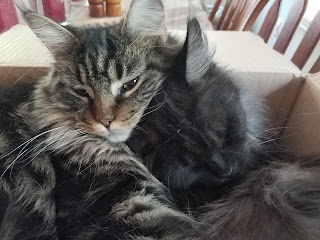I recently
attended a cat show in Brentwood, NY (Long Island), a show I’ve gone to twice
before. This year, weather permitting, I wanted to try the Mapquest
recommended route of taking the ferry from nearby New London, CT across the
Long Island Sound to Orient Point and driving another 90 minutes to the show. Driving the entire route was listed as 3 hours, 30 minutes, assuming there was no traffic on a Friday afternoon going toward New York City, over the Throgs Neck Bridge and on the Long Island Expressway.
Since it was
cool outside, I opted to leave the two cats I was showing in their crate in the
car during the ferry ride, figuring it would be easier than trying to lug two
carriers through the ferry. Clair, the Selkirk Rex Longhair and Trixie, the
Maine Coon kitten, would remain in the large crate together in my back seat, their
litter box readily accessible.
 |
| Clair and Trixie |
After I left
the show early on Sunday to avoid the expected snow storm, I again took the
ferry route. I called the ferry people ahead of time to see if I could show up
4 hours earlier than my reservation. I could.
Cats safely
snuggled in together in the car, I went upstairs to appreciate the view from
the front of the boat. As all the tables along the front window were taken, I
sat in one of the theater-style seats about 15 feet back from the front tables.
My view was of the tables and beyond that, Long Island Sound as the ferry
sailed toward New London.
The table
directly in front of me had a young family seated at it, with two adorable little
girls between the approximate ages of three and five years. The girls were being
kept busy with activity books and video games. Each girl had a pacifier in her mouth.
When the girls spoke, the pacifier stayed in, waggling like Groucho Marx’s cigar
as they said words I couldn’t understand. Their parents obviously understood Paci-ese,
answering questions or denying requests. If the girls ate any of the snacks in
front of them, the pacifier came out, the food went in and they plugged their mouths
back up with the pacifiers almost immediately.
Cringing as
I was at the speech impediments allowed in their daughters’ mouths at such
formidable ages, I noted that the parents seemed to be educated and attentive
to their children. The youngest had a tendency to speak loudly (even with the
pacifier) and her parents hushed her each time she did so, making her keep her
voice down to a normal level. I wondered if the kids were the kind who would
act out if their mouths weren’t plugged up all the time, but they seemed well-behaved
for their ages. There was no crying, tantrums or whining. Most babies need to
suckle something, but these children were beyond the toddler stage, potty
trained and very verbal. The oldest was probably in a pre-school program.
At one
point, the mother took the oldest girl over to where a service dog was seated
with its owner. The black lab had the brightly colored harness on, but the
owner was open to letting children pet her dog. After a few minutes, the child thought
it would be fun to pretend to be a dog herself and got down on her hands and
knees, barking. Mom immediately told her daughter to get off the dirty floor.
As the child stood up, her pacifier fell out of her mouth mid-bark, hitting the
floor. The little girl quickly squatted down and put it back in her mouth. Her mother was
offended about the dirty pacifier going into her daughter’s mouth, pulled it
out of her child’s and “cleaned it off” by, you guessed it, putting it into her
own mouth. After "cleaning" the pacifier, the mother popped it back in her daughter’s mouth.
Ew! I’ve
never understood this practice, but have seen it before. Some mothers have told
me they’re “flavoring” the pacifier. I’ve raised two children, have utilized
the “five-second rule” in controlled situations (fairgrounds, no; my kitchen
floor, yes), and sit my bare butt on public toilets if the need arises. I am not a germaphobe, but I just don’t get the paci-mouth-cleaning thing.
Not too
surprisingly, pediatricians discourage this practice, because, guess what, mother's mouths
are full of harmful bacteria, germs and swear words. Among the objects listed
as cleaner than a human mouth are a public toilet, subway railings, and urine.
I was amazed
to find through my extensive 3-minute Google research that there is one theory
that actually supports parents who mouth-clean their child’s pacifier, arguing
the practice may be boosting the child’s immune system. If that’s the belief, why
not just forego cleaning the pacifier at all and let the kid lick the floor?

















